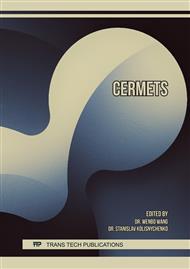[1]
C.M. Wang, H.F. Sun, Q. Song, Microstructure and performance analysis of Cr3C2-25%NiCr coating prepared by plasma spraying process, Key Eng. Mater. 373-374 (2008) 47-50.
DOI: 10.4028/www.scientific.net/kem.373-374.47
Google Scholar
[2]
L. Rovatti, E. Gariboldi, N. Lecis, L. Mondora, G. A. Mondora, Influence of long heat treatments on hardness and tribological behaviour of HVOF sprayed WC-CoCr and Cr3C2-25NiCr coatings, Mater. Sci. Forum 879 (2017) 1612-1617.
DOI: 10.4028/www.scientific.net/msf.879.1612
Google Scholar
[3]
H. Singh, M. Kaur, S. Prakash, High-temperature exposure studies of HVOF-sprayed Cr3C2-25(NiCr) / (WC-Co) coating, J. Therm. Spray Technol. 25 (2016) 1192-1207.
DOI: 10.1007/s11666-016-0424-6
Google Scholar
[4]
A. Kumar, A. Sharma, S.K. Goel, Erosion behaviour of WC–10Co–4Cr coating on 23-8-N nitronic steel by HVOF thermal spraying, Appl. Surf. Sci. 370 (2016) 418-426.
DOI: 10.1016/j.apsusc.2016.02.163
Google Scholar
[5]
R.K. Kumar, M. Kamaraj, S. Seetharamu, T. Pramod, P. Sampathkumaran, Effect of spray particle velocity on cavitation erosion resistance characteristics of HVOF and HVAF processed 86WC-10Co4Cr hydro turbine coatings, J. Therm. Spray Technol. 25 (2016).
DOI: 10.1007/s11666-016-0427-3
Google Scholar
[6]
A. Urbahs, J. Rudzitis, K. Savkovs, M. Urbaha, I. Boiko, A. Leitans, J. Lungevics, Titanium compound erosion-resistant nano-coatings, Key Eng. Mater. 674 (2016) 283-288.
DOI: 10.4028/www.scientific.net/kem.674.283
Google Scholar
[7]
A. Hamilton, A. Sharma, U. Pandel, Effect of impingement angle on erosion resistance of HVOF sprayed WC-10Co-4Cr coating on CA6NM steel, Key Eng. Mater. 751 (2017) 79-83.
DOI: 10.4028/www.scientific.net/kem.751.79
Google Scholar
[8]
D. Shin, A. Hamed, Influence of micro–structure on erosion resistance of plasma sprayed 7YSZ thermal barrier coating under gas turbine operating conditions, Wear 396-397 (2017) 34-47.
DOI: 10.1016/j.wear.2017.11.005
Google Scholar
[9]
H. Arabnejad, S.A. Shirazi, B.S. Mclaury, H.J. Subramani, L.D. Rhyne, The effect of erodent particle hardness on the erosion of stainless steel, Wear 332-333 (2015) 1098-1103.
DOI: 10.1016/j.wear.2015.01.017
Google Scholar
[10]
V. Bonache, M.D. Salvador, J.C. García, V. García, E. Sánchez, M. Vicent, Study of erosion behaviour of conventional and nanostructured WC-12Co coatings sprayed by atmospheric plasma, Key Eng. Mater. 423 (2010) 35-40.
DOI: 10.4028/www.scientific.net/kem.423.35
Google Scholar
[11]
X. Ding, X.D. Cheng, J. Shi, C. Li, C.Q. Yuan, Z.X. Ding, Influence of WC size and HVOF process on erosion wear performance of WC-10Co4Cr coatings, Int. J. Adv. Manuf. Technol. 5 (2017) 1-10.
DOI: 10.1007/s00170-017-0795-y
Google Scholar
[12]
M.S. Lamana, A.G.M. Pukasiewicz, S. Sampath, Influence of cobalt content and HVOF deposition process on the cavitation erosion resistance of WC-Co coatings, Wear s398–399 (2018) 209-219.
DOI: 10.1016/j.wear.2017.12.009
Google Scholar
[13]
G.C. Ji, C.J. Li, Y.Y. Wang, W.Y. Li, Erosion performance of HVOF-sprayed Cr3C2-NiCr coatings, J. Therm. Spray Technol. 16 (2007) 557-565.
DOI: 10.1007/s11666-007-9052-5
Google Scholar
[14]
G.J. Yang, C.J. Li, S.J. Zhang, C.X. Li, High-temperature erosion of HVOF sprayed Cr3C2-NiCr coating and mild steel for boiler tubes, J. Therm. Spray Technol. 17 (2008) 782-787.
DOI: 10.1007/s11666-008-9222-0
Google Scholar
[15]
C.J. Li, H. Yang, H. Li, Effect of gas condition on HVOF flame and properties of WC-Co coatings, Mater. Manuf. Processes 14 (1999) 383-395.
DOI: 10.1080/10426919908914834
Google Scholar
[16]
Z.X. Ding, Q. Wang, Z.L. Liu, Performance study of erosion wear of nanostructured WC-12Co coatings sprayed by HVOF, Key Eng. Mater. 373-374 (2008) 27-30.
DOI: 10.4028/www.scientific.net/kem.373-374.27
Google Scholar
[17]
P.H. Shipway, I.M. Hutchings, The role of particle properties in the erosion of brittle materials, Wear 193 (1996) 105-113.
DOI: 10.1016/0043-1648(95)06694-2
Google Scholar



